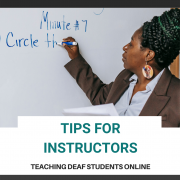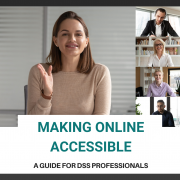Many deaf students take classes online or complete their whole educational programs online, even before the COVID-19 pandemic — almost 46% had taken at least one course online. These students often experience challenges with receiving equitable access for online courses.
There are three main types of online classes: synchronous (real-time), asynchronous (self-paced), and hybrid (part synchronous and part asynchronous). Accommodations needed for each type might be different.
TOP TIPS
ACCOMMODATIONS MAY CHANGE
Some students will need different accommodations for an online course than they needed for an in-person class.
TALK TO THE STUDENT
Ask the student what their needs are and if their accommodations are working.
CONSIDER OTHER FACTORS
The students and the institution need the right internet and equipment for remote services to work as intended. Be prepared to provide additional equipment to the student.
UNDERSTAND YOUR TECHNOLOGY
Different platforms have different accessibility features. Understand all the features of whichever platform you’re using.
THINK ABOUT TRAINING
Students, faculty, service providers, and administrators may need training to use the platform properly.
PLAN FOR ACCESS
Access and accommodations for online learning cannot be an afterthought. Accessible classes benefit everyone, not just students with disabilities.
Synchronous (Real-Time) Online Classes
Synchronous classes are similar to in-person instruction in that everything happens in real-time. Many deaf students will access course content using the same accommodations they used for in-person learning, but provided remotely. Other students will need different accommodations online.
Ask the student what modifications they need to their accommodations, and check in regularly to make sure the provided accommodations are working.
Accommodations are just one part of ensuring the deaf student has equitable access to an online course. Ensure your institution and the students have the appropriate infrastructure in place for online learning — including access to high-speed internet, proper equipment, and other considerations.
Many institutions use several different online learning platforms and you should understand the accessibility features for each.
Staff and deaf students may need training on how to use features in different platforms to make sure communication is accessible, including how to pin the interpreter, access real-time captions, mute microphones, and turn video on and off.
Considerations for Synchronous Online Classes
For communication to be effective during synchronous courses, more time and attention needs to be paid to the flow of communication during the class.
Faculty need to set up the environment ahead of time, and closely moderate discussion to ensure everyone is able to participate and absorb the information.
The following are some tips that faculty should share:
- Ensure only one person speaks at a time.
- The person speaking should identify themselves first.
- Allow for natural pauses in conversation, giving service providers enough time to translate messages.
- Elicit feedback from deaf students and service providers on communication.
Asynchronous (Self-Paced) Online Classes
If the student has been approved for sign language interpreters in their accommodation plan, this type of service should continue online.
The student may need an interpreted video of pre-recorded course audio. Interpreters can also be available if the deaf student needs to communicate with other students or the instructor.
When providing interpreters for direct translation of written text (live) or signed videos of online text, discuss the following key considerations with the deaf student:
- Course objectives and activities and how those objectives can be achieved with accommodations present.
- The student’s primary mode of communication.
- Barriers in accessing the online learning platform, and within the platform.
- If the accommodations constitute a fundamental alteration to the course material.
Tips for Deaf Students
Whether you have taken an online class before or are new to this, remember: accommodations don’t stop because you are now learning remotely.
Here are some strategies for you to take control of your online learning and set yourself up for success.
For more information and advice, visit the students and families section of our COVID-19 Information Page.









